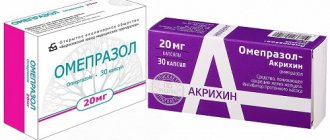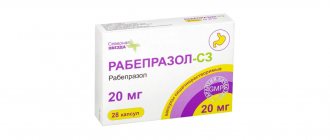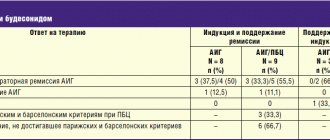Rabeprazole-SZ, 10 mg, enteric capsules, 14 pcs.
Inside.
Rabeprazole-SZ capsules should be swallowed whole. It has been established that neither time of day nor food intake affects the activity of rabeprazole.
For gastric ulcers in the acute stage and anastomotic ulcers
It is recommended to take 10 or 20 mg orally once a day. Typically, cure occurs after 6 weeks of therapy, but in some cases the duration of treatment can be increased by another 6 weeks.
With duodenal ulcer in the acute stage
It is recommended to take 20 mg orally once a day. In some cases, a therapeutic effect occurs when taking 10 mg once a day. The duration of treatment is from 2 to 4 weeks. If necessary, the duration of treatment can be increased by another 4 weeks.
In the treatment of erosive GERD or reflux esophagitis
It is recommended to take 10 or 20 mg orally once a day. The duration of treatment is from 4 to 8 weeks. If necessary, the duration of treatment can be increased by another 8 weeks.
During maintenance therapy for GERD
It is recommended to take 10 or 20 mg orally once a day. The duration of treatment depends on the patient's condition.
For non-erosive gastroesophageal reflux disease without esophagitis
It is recommended to take 10 or 20 mg orally once a day.
If symptoms do not disappear after 4 weeks of treatment, the patient should be further examined. After relief of symptoms, to prevent their subsequent occurrence, the drug should be taken orally at a dose of 10 mg 1 time per day as required.
For the treatment of Zollinger-Ellison syndrome and other conditions characterized by pathological hypersecretion,
the dose is selected individually. The initial dose is 60 mg per day, then the dose is increased and the drug is prescribed at a dose of up to 100 mg per day in a single dose or 60 mg 2 times a day. For some patients, fractional dosing of the drug is preferable. Treatment should be continued as clinically necessary. In some patients with Zollinger-Ellison syndrome, the duration of treatment with rabeprazole was up to one year.
For eradication of Helicobacter pylori
It is recommended to take 20 mg orally 2 times a day according to a specific regimen with appropriate combinations of antibiotics. The duration of treatment is 7 days.
Patients with renal and liver failure.
No dose adjustment is required for patients with renal failure.
In patients with mild to moderate hepatic impairment, blood concentrations of rabeprazole are usually higher than in healthy volunteers. When prescribing Rabeprazole-SZ to patients with severe liver failure, caution should be exercised.
Elderly patients.
No dose adjustment is required.
Children.
The safety and effectiveness of rabeprazole 20 mg for the short-term (up to 8 weeks) treatment of GERD in children aged 12 years and over is confirmed by extrapolation of the results of adequate and well-controlled studies confirming the effectiveness of rabeprazole in adults and safety and pharmacokinetic studies in pediatric patients.
The recommended dose for children aged 12 years and over is 20 mg once a day for up to 8 weeks.
The safety and effectiveness of rabeprazole for the treatment of GERD in children younger than 12 years of age have not been established. The safety and effectiveness of rabeprazole for other indications has not been established in pediatric patients.
Rabeprazole-SZ enteric capsules 10 mg 28 pcs.
Rabeprazole capsules should be swallowed whole. It has been established that neither time of day nor food intake affects the activity of rabeprazole. For gastric ulcers in the acute stage and anastomotic ulcers, it is recommended to take 10 mg or 20 mg orally once a day. Usually cure occurs after 6 weeks of therapy, but in some cases the duration of treatment can be increased by another 6 weeks. For duodenal ulcers in the acute stage, it is recommended to take 20 mg orally once a day. In some cases, a therapeutic effect occurs when taking 10 mg once a day. The duration of treatment is from 2 to 4 weeks. If necessary, the duration of treatment can be increased by another 4 weeks. When treating erosive gastroesophageal reflux disease (GERD) or reflux esophagitis, it is recommended to take 10 mg or 20 mg orally once a day. The duration of treatment is from 4 to 8 weeks. If necessary, the duration of treatment can be increased by another 8 weeks. For maintenance therapy of gastroesophageal reflux disease (GERD), it is recommended to take 10 mg or 20 mg orally once a day. The duration of treatment depends on the patient's condition. For non-erosive gastroesophageal reflux disease (NERD) without esophagitis, it is recommended to take 10 mg or 20 mg orally once a day. If symptoms do not disappear after four weeks of treatment, the patient should be further examined. After relief of symptoms, to prevent their subsequent occurrence, the drug should be taken orally at a dose of 10 mg once a day as required. For the treatment of Zollinger-Ellison syndrome and other conditions characterized by pathological hypersecretion, the dose is selected individually. The initial dose is 60 mg per day, then the dose is increased and the drug is prescribed at a dose of up to 100 mg per day with a single dose or 60 mg twice a day. For some patients, fractional dosing of the drug is preferable. Treatment should be continued as clinically necessary. In some patients with Zollinger-Ellison syndrome, the duration of treatment with rabeprazole was up to one year. To eradicate Helicobacter pylori, it is recommended to take 20 mg orally 2 times a day according to a specific regimen with appropriate combinations of antibiotics. The duration of treatment is 7 days. Patients with renal and liver failure. No dose adjustment is required for patients with renal failure. In patients with mild to moderate hepatic impairment, blood concentrations of rabeprazole are usually higher than in healthy volunteers. When prescribing Rabeprazole to patients with severe liver failure, caution should be exercised. Elderly patients. No dose adjustment is required. Children. The safety and effectiveness of rabeprazole 20 mg for the short-term (up to 8 weeks) treatment of GERD in children 12 years of age and older is supported by extrapolation from adequate and well-controlled studies supporting the effectiveness of rabeprazole in adults and safety and pharmacokinetic studies in pediatric patients. The recommended dose for children aged 12 years and over is 20 mg once daily for up to 8 weeks. The safety and effectiveness of rabeprazole for the treatment of GERD in children younger than 12 years of age have not been established. The safety and effectiveness of rabeprazole for other indications has not been established in pediatric patients.
Rabeprazole-SZ 20 mg 28 pcs. enteric capsules in Moscow
Rabeprazole-SZ capsules should be swallowed whole. It has been established that neither time of day nor food intake affects the activity of rabeprazole. For gastric ulcers in the acute stage and anastomotic ulcers, it is recommended to take 10 mg or 20 mg orally once a day. Usually cure occurs after 6 weeks of therapy, but in some cases the duration of treatment can be increased by another 6 weeks.
For duodenal ulcers in the acute stage, it is recommended to take 20 mg orally once a day. In some cases, a therapeutic effect occurs when taking 10 mg once a day. The duration of treatment is from 2 to 4 weeks. If necessary, the duration of treatment can be increased by another 4 weeks.
When treating erosive gastroesophageal reflux disease (GERD) or reflux esophagitis, it is recommended to take 10 mg or 20 mg orally once a day. The duration of treatment is from 4 to 8 weeks. If necessary, the duration of treatment can be increased by another 8 weeks.
For maintenance therapy of gastroesophageal reflux disease (GERD), it is recommended to take 10 mg or 20 mg orally once a day. The duration of treatment depends on the patient's condition.
For non-erosive gastroesophageal reflux disease (NERD) without esophagitis, it is recommended to take 10 mg or 20 mg orally once a day
If symptoms do not disappear after four weeks of treatment, the patient should be further examined. After relief of symptoms, to prevent their subsequent occurrence, the drug should be taken orally at a dose of 10 mg once a day as required.
For the treatment of Zollingeo-Ellison syndrome and other conditions characterized by pathological hypersecretion. the dose is selected individually. The initial dose is 60 mg per day, then the dose is increased and the drug is prescribed at a dose of up to 100 mg per day with a single dose or 60 mg twice a day. For some patients, fractional dosing of the drug is preferable. Treatment should be continued as clinically necessary. In some patients with Zollinger-Ellison syndrome, the duration of treatment with rabeprazole was up to one year.
For Helicobacter pylori
It is recommended to take 20 mg orally 2 times a day according to a specific regimen with appropriate combinations of antibiotics. The duration of treatment is 7 days.
Patients with renal and hepatic insufficiency No dose adjustment is required for patients with renal insufficiency. In patients with mild to moderate hepatic impairment, blood concentrations of rabeprazole are usually higher than in healthy volunteers. When prescribing Rabeprazole-SZ to patients with severe liver failure, caution should be exercised. Elderly patients No dose adjustment is required.
Children
The safety and effectiveness of rabeprazole 20 mg for the short-term (up to 8 weeks) treatment of GERD in children 12 years of age and older is supported by extrapolation from adequate and well-controlled studies supporting the effectiveness of rabeprazole in adults and safety and pharmacokinetic studies in pediatric patients. The recommended dose for children aged 12 years and over is 20 mg once daily for up to 8 weeks.
The safety and effectiveness of rabeprazole for the treatment of GERD in children younger than 12 years of age have not been established. The safety and effectiveness of rabeprazole for other indications has not been established in pediatric patients.
RABEPRAZOLE-SZ enteric capsules 20 mg No. 14
Pharmacotherapeutic group Drug that reduces the secretion of gastric glands - proton pump inhibitor ATC code: [A02BC04] Pharmacological properties Pharmacodynamics Rabeprazole belongs to the class of antisecretory substances, benzimidazole derivatives. Suppresses the secretion of gastric juice by specifically inhibiting H+ /K+ -ATPase on the secretory surface of gastric parietal cells. Blocks the final stage of hydrochloric acid secretion, reducing the content of basal and stimulated secretion, regardless of the nature of the stimulus. Possessing high lipophilicity, it easily penetrates into the parietal cells of the stomach, concentrates in them, exerting a cytoprotective effect and increasing the secretion of bicarbonate. The antisecretory effect after oral administration of 20 mg of rabeprazole occurs within 1 hour and reaches a maximum after 2-4 hours; inhibition of basal and food-stimulated acid secretion 23 hours after taking the first dose is 62 and 82%, respectively, and lasts up to 48 hours. When you stop taking it, secretory activity is restored within 1-2 days. During the first 2-8 weeks of rabeprazole therapy, the concentration of gastrin in the blood plasma increases (which is a reflection of the inhibitory effect on the secretion of hydrochloric acid) and returns to baseline levels 1-2 weeks after its discontinuation. Rabeprazole does not have anticholinergic properties and does not affect the central nervous system (CNS), cardiovascular or respiratory systems. While taking rabeprazole, consistent changes in the morphological structure of enterochromaffin-like cells, the severity of gastritis, the incidence of atrophic gastritis, intestinal metaplasia, or the spread of Helicobacter pylori infection were not detected. 3 Pharmacokinetics Absorption Rabeprazole is rapidly absorbed from the intestine, and its maximum plasma concentrations are reached approximately 3.5 hours after administration of a 20 mg dose. Changes in maximum plasma concentrations (Cmax) and area under the concentration-time curve (AUC) of rabeprazole are linear in the dose range from 10 to 40 mg. Absolute bioavailability after oral administration of 20 mg (compared to intravenous administration) is approximately 52%. In addition, bioavailability does not change with repeated dosing of rabeprazole. In healthy volunteers, the plasma half-life is approximately 1 hour (ranging from 0.7 to 1.5 hours) and the total clearance is 3.8 ml/min/kg. In patients with chronic liver damage, the AUC is doubled compared to healthy volunteers, indicating a decrease in first-pass metabolism, and the plasma half-life is increased by 2 to 3 times. Neither the time of taking the drug during the day nor antacids affect the absorption of rabeprazole. Taking the drug with fatty foods slows down the absorption of rabeprazole by 4 hours or more, but neither Cmax nor the degree of absorption changes. Distribution In humans, the degree of binding of rabeprazole to plasma proteins is about 97%. Metabolism and excretion In healthy subjects, no unchanged drug was found in the urine after taking a single 20 mg oral dose of 14C-labeled rabeprazole. About 90% of rabeprazole is excreted in the urine mainly in the form of two metabolites: a conjugate of mercapturic acid (M5) and carboxylic acid (M6), as well as in the form of two unknown metabolites identified during toxicological analysis. The remainder of the rabeprazole taken is excreted in the feces. The total elimination is 99.8%. These data indicate a small excretion of rabeprazole metabolites in bile. The main metabolite is thioester (M1). The only active metabolite is desmethyl (M3), but this was observed at low concentrations in only one study participant after taking 80 mg rabeprazole. End-stage renal disease In patients with stable end-stage renal disease who require maintenance hemodialysis (creatinine clearance
Rabeprazole-SZ, 14 pcs., 20 mg, enteric capsules
Inside.
Rabeprazole-SZ capsules should be swallowed whole. It has been established that neither time of day nor food intake affects the activity of rabeprazole.
For gastric ulcers in the acute stage and anastomotic ulcers
It is recommended to take 10 or 20 mg orally once a day. Typically, cure occurs after 6 weeks of therapy, but in some cases the duration of treatment can be increased by another 6 weeks.
With duodenal ulcer in the acute stage
It is recommended to take 20 mg orally once a day. In some cases, a therapeutic effect occurs when taking 10 mg once a day. The duration of treatment is from 2 to 4 weeks. If necessary, the duration of treatment can be increased by another 4 weeks.
In the treatment of erosive GERD or reflux esophagitis
It is recommended to take 10 or 20 mg orally once a day. The duration of treatment is from 4 to 8 weeks. If necessary, the duration of treatment can be increased by another 8 weeks.
During maintenance therapy for GERD
It is recommended to take 10 or 20 mg orally once a day. The duration of treatment depends on the patient's condition.
For non-erosive gastroesophageal reflux disease without esophagitis
It is recommended to take 10 or 20 mg orally once a day.
If symptoms do not disappear after 4 weeks of treatment, the patient should be further examined. After relief of symptoms, to prevent their subsequent occurrence, the drug should be taken orally at a dose of 10 mg 1 time per day as required.
For the treatment of Zollinger-Ellison syndrome and other conditions characterized by pathological hypersecretion,
the dose is selected individually. The initial dose is 60 mg per day, then the dose is increased and the drug is prescribed at a dose of up to 100 mg per day in a single dose or 60 mg 2 times a day. For some patients, fractional dosing of the drug is preferable. Treatment should be continued as clinically necessary. In some patients with Zollinger-Ellison syndrome, the duration of treatment with rabeprazole was up to one year.
For eradication of Helicobacter pylori
It is recommended to take 20 mg orally 2 times a day according to a specific regimen with appropriate combinations of antibiotics. The duration of treatment is 7 days.
Patients with renal and liver failure.
No dose adjustment is required for patients with renal failure.
In patients with mild to moderate hepatic impairment, blood concentrations of rabeprazole are usually higher than in healthy volunteers. When prescribing Rabeprazole-SZ to patients with severe liver failure, caution should be exercised.
Elderly patients.
No dose adjustment is required.
Children.
The safety and effectiveness of rabeprazole 20 mg for the short-term (up to 8 weeks) treatment of GERD in children aged 12 years and over is confirmed by extrapolation of the results of adequate and well-controlled studies confirming the effectiveness of rabeprazole in adults and safety and pharmacokinetic studies in pediatric patients.
The recommended dose for children aged 12 years and over is 20 mg once a day for up to 8 weeks.
The safety and effectiveness of rabeprazole for the treatment of GERD in children younger than 12 years of age have not been established. The safety and effectiveness of rabeprazole for other indications has not been established in pediatric patients.


